WOMEN AT THE BATTLE OF GETTYSBURG
Understanding the Civil War from a Completely Different Perspective
By Sandy Levins
 | |
 March 8, 2006
March 8, 2006
CAMDEN, N.J. -- Although their actions rarely made it into the history books, woman were significantly involved in and around the epic battle of Gettyburg

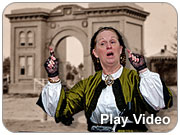
|
| Historical presenter Jane Peters Estes tells the story of the women who took part in all aspects of the greatest battle of the Civil War. Behind her is an image of the Gettysburg cemetery gate. | that turned the tide of the American Civil War, according to historian Jane Peters Estes.
In an afternoon presentation at the Camden County Historical Society, Ms. Estes provided a sweeping picture of the many women -- known and unknown -- who served as combatants or were otherwise directly engaged in the war's deadliest clash.
New Jersey history
The battle that hurled the Union and Confederate armies together across a landscape of rocky hills around a rural Pennsylvania town 100 miles west of Philadelphia was an event that riveted the attention of Camden and southern New Jersey. For one thing, it was widely known that General Lee's plan was to strike north into Union territory, take the capital at Harrisburg and march due east to capture Philadelphia. As in the Revolution, the seizure of Philadelphia would have made the breadbasket farmlands of South Jersey a battle zone for the food and resources needed by both armies to sustain themselves. For another, 17 New Jersey infantry, cavalry and artillery regiments were ordered into that battle and followed by the eyes and anxious hearts of thousands of families throughout the state.
Unprecedented carnage
The three-day battle in Pennsylvania's Adams County resulted in as many as
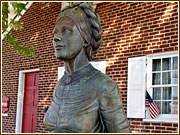
Photo: Hoag Levins
|
| Mary Virginia Wade, also known as Jenny Wade, was the only civilian killed in the Battle of Gettysburg. A life-sized statue stands in front of the house -- now a local tourist attraction. Larger photo. | 40,000 deaths and horrendous numbers of human and animal injuries. It laid waste to its structures and turned its civilian population of 2,400 into refugees hiding in cellars, holes and ditches. Amazingly, only a single civilian actually died in the battle -- 20-year-old Mary Virginia Wade, whose name has ever since been curiously misreported in the press as Jenny Wade, according to Ms. Estes.
The details of exactly how Ms. Wade was shot to death have long been the subject of controversy. The most commonly accepted version is that she was baking bread in her pregnant sister's home when a military bullet pierced two doors and struck her in the back.
That tale kicks off Ms. Estes' chronicle that provides a completely different human perspective on the battle and its aftermath. Much of her research was taken from journals kept by residents and visitors who lived through the experience, as well as letters and the documentation of soldiers, nurses and others who tramped across the region during and after the battle.
Eyewitness stories
"Fortunately, we have so many written accounts that we can tell the story by way of collective first person, eyewitness testimony," Ms. Estes told the Historical Society audience.
One account by a Union officer details his contacts with Josephine Miller,
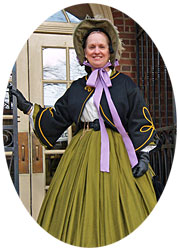
Photo: Hoag Levins
|
| Ms. Estes dresses in authentic period garb for her presentations. Here, she stands in the front doorway of the Camden County Historical Society headquarters wearing the clothes of an affluent 1863 woman. Larger photo. | a 23-year-old woman who lived on Emmettsburg Road, directly between the battle lines of the two armies. He wrote that he told Ms. Miller to flee her home immediately but that "she said she had a batch of bread baking in the oven and she would remain until it was done and then leave. When her bread was baked, it was given to our soldiers and devoured so eagerly that she concluded to remain and bake another batch. And so she continued until the end of the battle, baking and giving bread to all who came. The great artillery duel that shook the earth for miles around did not drive her from her oven. Pickett's men, who charged past her house, found her quietly baking bread and distributing it to the hungry."
Another woman living nearby, Amelia Harmon, and her aunt took refuge in the cellar of her own home as Union troops took over the house. Ms. Estes said she wrote, "I could hear the tumult above. The crack of rifles, the hurried orders, the outside mingle with the roar of heavy artillery, galloping horses, yelling troops and the occasional boom of cannon and, above it all, we could hear the beating of our hearts."
Disguised female soldiers
"Some women came to town with the armies," said Ms. Estes. "There were women who disguised themselved as men and fought with both the Union and Confederate armies during the war. Of those detected (as females), we know that seven were wounded, seven were taken to prisoner-of-war camps, nine died on battlefields, and
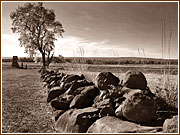
Photo: Hoag Levins
|
| One of the Confederate soldiers killed while storming this stone wall along Cemetery Ridge during the Battle of Gettysburg was a women. She died taking part in Pickett's Charge. Larger photo. | at least six gave birth to babies. We know that a woman soldier was killed at the Battle of Gettysburg; she was found dead on the west side of the stone wall on Cemetery Ridge.
She had participated in Pickett's charge. And we know she was not the only Confederate female there. A wounded soldier from Michigan wrote the following account while recuperating in the hospital: 'I must tell you that we have a female Secesh here. She was wounded at Gettysburg but our doctors soon found her out. They say she is very good looking but the poor girl has lost a leg. It is a great pity she did not stay at home with her mother but she gets good care and kind treatment.'"
"Why would women have disguised themselves to become soldiers?," Ms. Estes asked. "Money. It was a different world then. If your husband, father, brother or whoever was supporting you went off to war, there were no food stamps, no welfare, and women were not educated to support themselves. So they joined the Army to be paid and fed. Some joined for love because they decided to go with their husband or boyfriend. And we know some of them went just for the adventure of it."
Woman warrior Marie Tepe
One of those was a Philadelphia women, Marie Tepe, Mrs. Estes said. Ms. Tepe was born in France and emigrated to America as a teenager. She was living with a tailor at the time the war broke out and when he enlisted in the volunteers, so did she. With a .44 caliber pistol slung on her hip.
"Marie Tepe was wounded at the Battle of Fredericksburg,
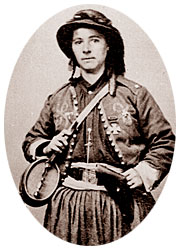
|
| Marie Tepe was a female Union soldier who served under fire at the Battle of Gettysburg. She wore a .44 caliber pistol on her hip and a uniform she made herself. Larger photo. | where she took a ball in her ankle, and she served under fire in 13 battles, including Gettysburg -- but how many of you have ever heard her name?," Ms. Estes asked.
Another, Ms. Estes said, was Lorinda Anna Blair. "She was of Dutch descent, described as 5'3", fair complexion, brown hair, vigorous constitution, and decidedly good looking. Her dress on entering the battle was a riding dress with two small pistols in her belt. She was wounded slightly in her left hand and they said her dress and bonnet had many bullet holes in them. She received the Kearney Cross for bravery under fire. How many of you knew or even suspected that a woman received a medal for bravery in battle at Gettysburg?"
In the early 1990s, Ms. Estes herself began a search for the grave of Ms. Blair. She eventually located it in Arlington Cemetery, but discovered that the curator had no knowledge of the details of the female warrior's life. Ironically, Ms. Blair was not buried in that national military cemetery because of her own exploits, but because she later married a veteran and was, as his wife, legally entitled to a grave plot.
African-American women
African-American women had a particularly hard time at Gettysburg, Ms. Estes said. The Confederate Army had been authorized to seize any person of color they encountered on their march north and send them south as "captured contraband" to be returned to slavery --
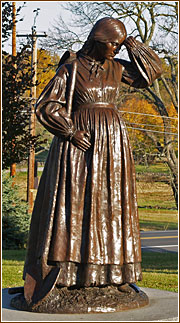
Photo: Hoag Levins
|
| Elizabeth Thorn, pregnant wife of the manager of Gettysburg's main cemetery, dug 102 graves for dead soldiers after the battle. A life-size sculpture at the cemetery commemorates her deeds. Larger photo. | a direct response to the Union Army's systematic freeing of the slaves encountered during its campaigns in Southern territory. Written accounts tell of black residents of the region fleeing the town, into the hills, while others were taken into custody by the Confederates. At least one -- identified only as "Aunt Liz" -- escaped her captors by ducking into the Christ Lutheran Church and hiding in the belfry for days without food or water.
"But the story I like best about Gettysburg is about Lydia Smith," said Ms. Estes. "She was a poor colored woman who had saved a little money by years of hard labor. After the battle, she hired a wagon and horse and traveled through the farms, telling of the thousands of suffering men. She accepted donations of food and clothing and, when the donations dried up, began spending her own money. Each day, with her wagon heaped high, she turned toward the hospitals; and when she reached them, weary from miles of travel, she began to distribute the articles she had brought. To Union soldiers only? No. Union and Confederate alike. In the latter, she was able to see past their role as warriors who were fighting to perpetuate slavery and view them only as wounded, suffering humans. She continued to provide the makeshift hospital populations around Gettysburg with food, clothing and delicacies until she had spent her entire life savings."
|











